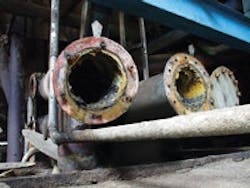About the author:
Donald Townley, P.E., is business manager for Corzan Industrial Systems, a part of The Lubrizol Corp. Townley can be reached at [email protected].
For decades it was assumed that corrosion was a natural result of the water treatment process. Metallic piping in a highly corrosive environment typically results in corrosion, which severely limits the service life and performance of the entire piping distribution system. In many plants, metallic piping systems are repaired and replaced routinely as a result of pinhole leaks and premature failures.
There is, however, a solution that permanently eliminates pipe corrosion problems, as a number of wastewater treatment plants (WWTPs) and water treatment plants (WTPs) have discovered. It is chlorinated polyvinyl chloride (CPVC) pipe and fittings. Although newer to the market than carbon steel and many high-end alloys that some plants have tried as part of their standard corrosion control technologies, CPVC has a long-established track record in a wide range of industrial operations that require the use of corrosive chemicals, such as water and wastewater treatment.
WWTP Application
Lubrizol’s Avon Lake, Ohio, WWTP is just one of many facilities that successfully puts CPVC pipe and fittings to the test. Lubrizol, a global manufacturer of specialty chemicals, manufactures a number of chemical products at its Avon Lake facility, including thermoplastic polyurethane, polyurethane dispersion, high-performance latex products and a variety of additives used primarily in personal care products.
To effectively treat a diverse mix of process waste streams before sending its water back to the local municipal plant, Lubrizol uses an alum-based polymer coagulant to break solids out of the solution and into suspension. The coagulant, which weighs 25% more than water, is pumped through a 1-in. line and fed into the wastewater in a mix tank. The challenge prior to the conversion to CPVC was the low pH level of the feed stream, which wreaked havoc on the pump room’s stainless steel piping system.
The stainless system had been in operation for only two years when it began to develop ongoing corrosion problems. By the third year, the operations team was spending so much time repairing the pipe and replacing full sections of the line that it was decided to completely replace the material to avoid downtime and safety risks associated with the overhead leaks.
The team recommended CPVC pipe and fittings because it was familiar with the product’s benefits from an earlier installation. CPVC pipe and fittings were installed more than 10 years prior for the plant’s polymer coagulant bulk unloading line. After more than a decade of operating 24/7 in a harsh chemical environment, the CPVC line continued to operate reliably without downtime or maintenance issues.
WTP Application
Another example of how CPVC effectively replaced a failed metallic system took place in Philadelphia at the city’s largest WTP. Originally constructed in the early 1900s, the plant treats an average of 200 million gal of water a day to supply nearly 60% of the city’s 1.5 million-plus population.
When the Philadelphia Water Department decided to update much of the plant’s rubber-lined steel pipes and feed lines, its engineers specified CPVC to provide a cost-effective, low-maintenance industrial piping solution. The conversion was completed in two phases over a one-year period.
Like many other treatment plants across the country, Philadelphia had replaced chlorine with sodium hypochlorite in its treatment process. As a result, the steel pipes were proving to be more vulnerable to the corrosive effects of the sodium hypochlorite. CPVC, on the other hand, has proven with its 50-plus-year track record to offer a high level of chemical resistance against even some of the harshest treatment chemicals.
The Philadelphia WTP ultimately installed nearly 5,000 ft of CPVC piping, including 0.5-, 1.5-, 3- and 4-in. diameters to fit different applications. Because CPVC pipe offers a smooth inner surface that is resistant to scaling and fouling, in some cases the plant was able to downsize its piping needs.
The installation of the CPVC pipe and fittings did not require any welding, so the process was fast and easy, minimizing plant downtime. The system was installed using a solvent cement joining system. Because CPVC pipe is between one-sixth and one-eighth the weight of comparably sized steel pipe, heavy equipment is not needed to lift and install the pipe.
The Case for CPVC
In both the Lubrizol and Philadelphia examples, the CPVC pipe and fittings proved to have the necessary mechanical strength to handle the temperature and pressure demands of water and wastewater treatment operations. The CPVC systems installed were pressure rated for operation up to 200°F, well above the plants’ highest temperatures.
For engineers and plant managers who are concerned that CPVC cannot meet demands, it is important to note that within the past year a new CPVC technology was introduced to effectively increase the pipe’s overall pressure rating.
Today’s WWTPs and WTPs no longer have to accept corrosion in their operations, despite the fact that they are working with harsher disinfectants to meet tighter discharge regulations. CPVC has proven to be a viable alternative that not only eliminates corrosion concerns but also results in lower total installed costs (thanks to competitive material pricing and lower labor costs as a result of its fast, easy installation methods). With advanced technologies that enable certain CPVC pipe and fittings to handle even greater pressure, there has never been a better time to consider this thermoplastic for new construction or plant upgrades.
Download: Here
